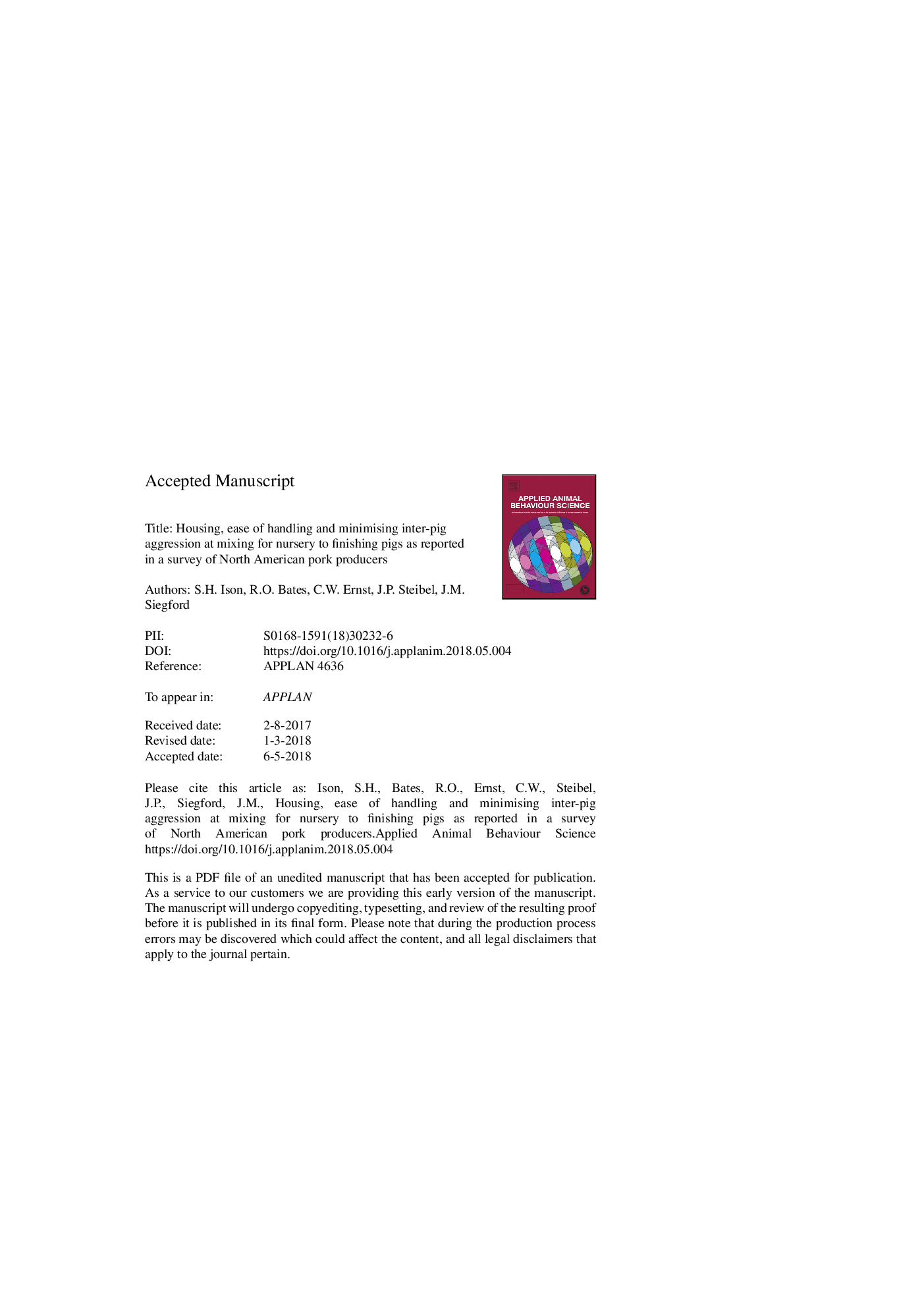| کد مقاله | کد نشریه | سال انتشار | مقاله انگلیسی | نسخه تمام متن |
|---|---|---|---|---|
| 8882729 | 1625301 | 2018 | 34 صفحه PDF | دانلود رایگان |
عنوان انگلیسی مقاله ISI
Housing, ease of handling and minimising inter-pig aggression at mixing for nursery to finishing pigs as reported in a survey of North American pork producers
ترجمه فارسی عنوان
مسکن، سهولت دست زدن و به حداقل رساندن حملات بین خوک در مخلوط کردن برای مهد کودک به خوک به اتمام است که در یک بررسی از تولید کنندگان گوشت خوک شمال
دانلود مقاله + سفارش ترجمه
دانلود مقاله ISI انگلیسی
رایگان برای ایرانیان
کلمات کلیدی
پرخاشگری کشاورزان، ادراک، خوک، نظر سنجی،
موضوعات مرتبط
علوم زیستی و بیوفناوری
علوم کشاورزی و بیولوژیک
علوم دامی و جانورشناسی
چکیده انگلیسی
Inter-pig aggression is a welfare issue that has undergone extensive research. Although management techniques have proven useful in minimising aggression in research settings, it is not known how often these are used on-farm. One objective of an online survey of North American pork producers was to learn about the housing, ease of handling, and management of nursery to finishing pigs, including what techniques were used to minimise aggression, how useful they were perceived to be and what were potential barriers to their use. Respondents were given a list of techniques to select which ones they used, and indicate how useful they perceived them to be on a five-point scale ('very useful' to 'not useful at all'). A step-wise binomial logistic regression was used to analyse the association between other factors and whether or not respondents reported that at least one technique was used. Respondents (nâ¯=â¯298), had nursery (11,604â¯Â±â¯4032, range: 1-950,000) and/or finishing pigs (18,999â¯Â±â¯5789, range: 2-1,500,000), or did not currently have pigs but answered the questions, at the time the survey was completed. Some had pigs of both stages (nâ¯=â¯181), and some had just nursery (nâ¯=â¯24), or finishing (nâ¯=â¯89) pigs. When asked if they regularly re-grouped unfamiliar pigs, 36% of all respondents selected yes (33% at nursery, 25% at finishing). Of all respondents, 53% reported using at least one technique to minimise re-grouping aggression. Techniques reported from most to least useful included: pre-weaning piglet socialisation (nâ¯=â¯19), using mixed weight pens (nâ¯=â¯9), night-time mixing (nâ¯=â¯50), mixing all pigs to a new pen (nâ¯=â¯108), barriers (nâ¯=â¯25), using specific mixing pens (nâ¯=â¯21), odour masking agents (nâ¯=â¯38), pre-exposure in a neighbouring pen (nâ¯=â¯45), and enrichment devices (nâ¯=â¯41). After stepwise selection, the best regression model for predicting the odds of using at least one technique included the factor pig stage (nursery, finisher, or both), as farms specialising in either nursery (Pâ¯<â¯0.001) or finishing pigs (Pâ¯<â¯0.001) only, had increased log odds of using a technique. Those that did not mix regularly had reduced odds (Pâ¯<â¯0.001) of using a technique, and those that used bedding tended to have increased odds of using a technique (Pâ¯=â¯0.08). Overall, producers avoided mixing unfamiliar pigs, but for systems in which regular mixing was used, techniques were more likely to be implemented to help minimise aggression. However, over a third of respondents who reported that they did not regularly mix at any stage, still indicated that they used at least one technique.
ناشر
Database: Elsevier - ScienceDirect (ساینس دایرکت)
Journal: Applied Animal Behaviour Science - Volume 205, August 2018, Pages 159-166
Journal: Applied Animal Behaviour Science - Volume 205, August 2018, Pages 159-166
نویسندگان
S.H. Ison, R.O. Bates, C.W. Ernst, J.P. Steibel, J.M. Siegford,
